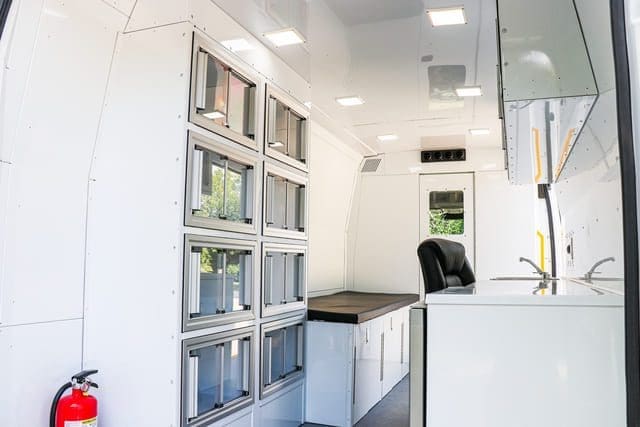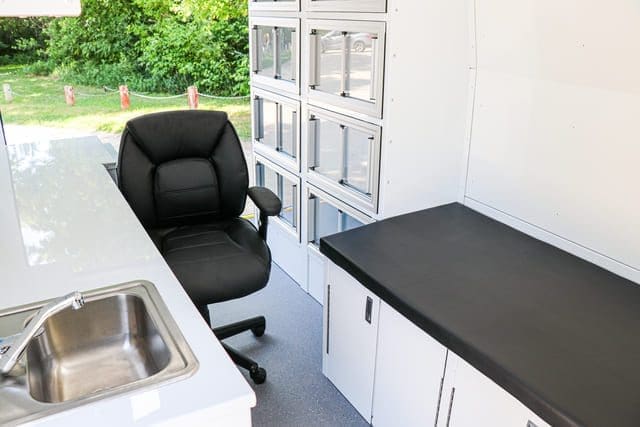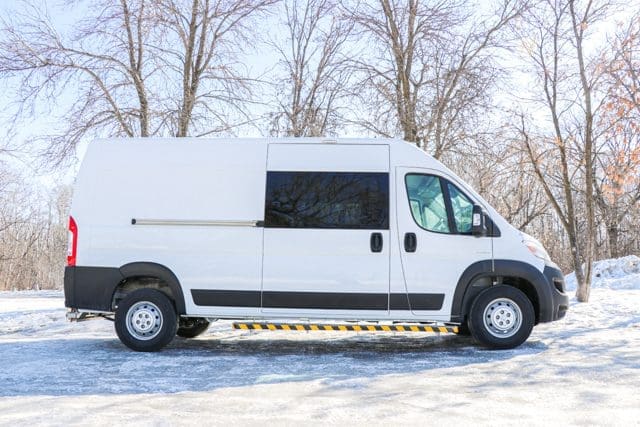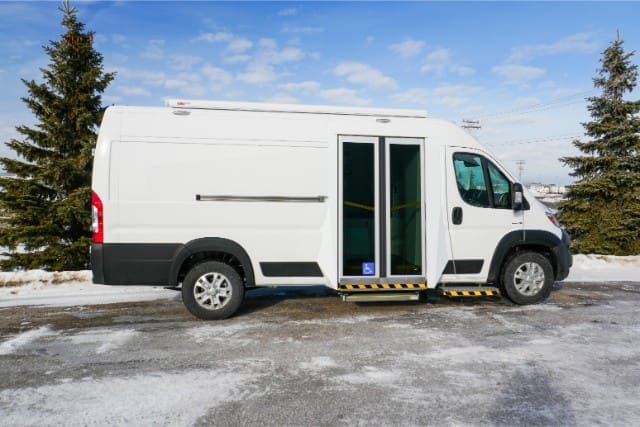Is your program or organization considering purchasing a mobile clinic vehicle, but you’re unsure of how it can help improve medical accessibility? Transportation challenges, the limited reach of healthcare services in some areas, and mobility challenges are all barriers to medical accessibility.
At AVAN Mobility, we help organizations reduce barriers to medical accessibility by manufacturing mobile clinic vehicles. We do our best to customize mobile clinic vehicles specific to your organization. That means if your organization needs specific equipment for your target population, we can, in most cases, make it happen.
In this article, you’ll learn about the top 5 ways a mobile clinic vehicle improves medical accessibility.
They include:
- Bringing healthcare to those with mobility issues
- Reducing transportation challenges
- Preventative care
- Reducing wait times
- Emergency support
1. Mobile clinic vehicles bring healthcare to those with mobility issues
Mobile clinic vehicles, like the ones from AVAN Mobility, bring healthcare right to your organization’s target community. They work as a moving doctor’s office with the right tools and medical staff. Because of this, people in the community won’t have to travel to get healthcare services.
Think about an elderly person with mobility issues living 6 hours from the nearest hospital. They just fell, and their hip is in severe pain. Because of their hip pain, pre-existing mobility issues, and remote location, they can’t just hop in a vehicle and visit a nearby clinic. It’s a much more lengthy and complicated process for them.
If your organization has a mobile clinic vehicle, it can roll right up to the elderly person’s neighborhood and give them the care they need, including an X-ray to see if the hip is broken.
2. Mobile clinic vehicles reduce transportation challenges for people in rural areas
Mobile clinic vehicles improve medical accessibility when they’re in places where it’s hard to get medical care due to long distances, bad road conditions, and treacherous weather. Rural areas don’t have the same access to healthcare that people in populated cities do.
More than half of all rural counties in the United States lack a single local hospital where a pregnant woman can get prenatal or labor and delivery care.
Try to picture yourself in the shoes of people living in a small town that’s nestled away from urban centers. For many, getting to the nearest hospital or healthcare facility takes hours. The journey might involve bumpy roads, and it’s quite dangerous if individuals have unreliable transportation methods.
The sheer distance and inconvenience make it very difficult for people living in these areas to get simple things like medical check-ups or urgent care.
Mobile clinic vehicles solve this problem by bringing medical care closer to these communities. With a mobile clinic vehicle, your organization can drive it around a community while serving each patient’s individual needs.
3. Mobile clinic vehicles provide preventative care for at-risk communities

Mobile clinic vehicles are a solution for addressing immediate medical needs. They also promote preventative care in communities. Preventative care is being proactive about health to prevent health problems from arising.
If your organization is doing regular check-ups and screenings, you can help detect health issues at an early stage. This includes cholesterol checks, blood pressure monitoring, and cancer screenings.
Preventative care improves a community’s health and reduces healthcare costs in the long run. When your organization catches issues before they turn into something more severe, individuals are less likely to need expensive treatments or even hospitalization. This is a huge benefit for individuals and their families and also alleviates the burden on the healthcare system.
Preventative care services could save over 100,000 lives in the U.S. every single year. Your organization could use a mobile clinic vehicle to add to those statistics.
Mobile medical vehicles and preventative care
Imagine you’re a farmer in a rural area. You work hard every day to grow crops and feed your family. Because of your remote location, you don’t have easy access to a health facility or a doctor. You don’t have health insurance or enough money to pay for medical bills. You also don’t have time to travel to the nearest town, that’s 8 hours away, for a check-up.
One day, a mobile clinic vehicle visits your area. It offers free health services to you and your neighbors. They check your blood pressure, cholesterol, and blood sugar levels. After that. they screen you for common cancers and give you advice on how to prevent or manage your conditions. They also give you some vitamins and supplements to boost your immunity.
After the check-up, you’re surprised to learn that you have high blood pressure and high cholesterol. You didn’t know that these could lead to serious problems, such as a heart attack or stroke. You also didn’t know that you could lower your risk by changing your diet and lifestyle.
The mobile clinic staff teaches you how to eat healthier, exercise more, and reduce stress. They also give you some medication to help control your blood pressure and cholesterol.
This example shows how a mobile medical vehicle can provide preventative care for an issue that could’ve easily ended in a farmer having a heart attack and not being able to support their family.
4. Mobile clinic vehicles reduce wait times for already overworked regional hospitals
Long wait times at healthcare clinics have been a persistent issue in the United States, and they impact patients’ access to timely medical care. According to a report by the Commonwealth Fund in 2020, the U.S. ranks last among 11 high-income countries for healthcare access, with wait times being a significant contributing factor. Here’s a closer look at this challenge and how mobile clinic vehicles can effectively address it:
Statistical snapshot: The Commonwealth Fund’s report revealed that about 32% of adults in the U.S. reported waiting more than two months for a specialist appointment in 2020, highlighting the extent of this issue.
Impact on patients: Long wait times can lead to delayed diagnoses and treatments, which can result in worsened health conditions. Patients often face frustration, stress, and financial burdens due to repeated clinic visits and time off work.
Mobile medical vans and reduced wait times
Meet Sarah, a hardworking single mom in a small town in the United States. Sarah’s daughter, Emily, developed a persistent cough that got worse over time. Sarah decided to seek medical help for Emily.
Sarah’s town had a local clinic, but getting an appointment there was a challenge. She called, and they told her the earliest available appointment with a specialist was more than two months away. The long wait was a problem for Sarah. Emily’s health couldn’t wait that long, and Sarah couldn’t afford to take multiple days off work for clinic visits.
One day, Sarah heard about a mobile clinic visiting her community. It was part of a program to bring healthcare closer to people who needed it. Sarah decided to give it a try. She made an appointment with the mobile clinic for the next week.
When the day arrived, Sarah and Emily went to the mobile clinic, which had been set up in a nearby parking lot. They were seen promptly at their scheduled time. A skilled healthcare provider examined Emily, diagnosed her condition, and provided the necessary treatment.
Thanks to the mobile clinic, Emily’s health improved, and she didn’t need to wait for months to see a specialist. Sarah didn’t have to miss too much work either, reducing her financial stress. This real-life example demonstrates how mobile clinic vehicles can make a significant difference by reducing wait times, providing timely care, and alleviating the burden on patients like Sarah who face long clinic wait times.
Mobile clinic vehicles go directly to areas where healthcare is hard to get. That means people don’t have to worry about the long drive or extended waiting times in busy clinics. Because mobile clinic vehicles also serve specific neighborhoods, the level of healthcare is more personalized.
5. Mobile clinic vehicles offer emergency healthcare support when disasters strike
Sometimes, things can go really wrong. Natural disasters, like hurricanes, floods, or earthquakes, can hit a community hard. Or there might be a sudden outbreak of a serious illness that spreads quickly. In situations like these, people need medical help right away.
This is where your organization’s mobile clinic vehicle will be a big help. Mobile clinics will rush to places that are in trouble. Depending on your level of customization, mobile clinic vehicles are stocked with all the medical equipment and supplies needed to treat sick or injured people. So, even in the middle of a disaster, people can get the medical care they need.
Mobile medical vans and emergency healthcare support
Let’s take a look at another example of how mobile medical vans can help out.
We’ll use a coastal town named Harborville for this example. It’s a peaceful place by the sea, but it faces a big problem every hurricane season. One year, a massive hurricane was on its way, and the people of Harborville were worried.
As the storm hit, Harborville lost power. Streets were flooded, and the local hospital’s generators failed. Debris injured people, and some needed urgent medical attention. But with the hospital in the dark, things looked grim.
That’s when the mobile clinic vehicle from AVAN Mobility came into action. It had its own power supply and was equipped with all the necessary medical equipment. Despite the heavy rain and strong winds, the dedicated medical team on board rushed to the scene.
The mobile clinic became a beacon of hope in Harborville. It provided immediate medical care to those injured in the hurricane’s wrath, treating wounds, providing medications, and even offering a place for people to shelter from the storm.
In this example, you can clearly see how the mobile clinic vehicle acted as a lifeline during a disaster. It showed how important these vehicles are in emergencies, ensuring that even when everything else fails, healthcare remains accessible to those in need.
Your next steps toward getting a mobile clinic vehicle with AVAN Mobility

You made it to this article because you wondered how mobile clinic vehicles can improve medical accessibility.
Now that you’ve read this far and learned about the top 5 ways it can do that, you’ll want to read our article on starting a mobile clinic program.
Once you’ve read that and learned more about starting a mobile clinic program, you should read our article on tips for fundraising for a mobile clinic van.
Finally, after you secure funding for your mobile clinic vehicle, take a look at our article on buying a mobile clinic vehicle and what our process at AVAN Mobility entails.
At AVAN Mobility, we’ve been manufacturing mobile clinic vehicles for over a decade, and we know how difficult the process of acquiring one can be for some organizations. That’s why we do our best to provide you with resources and try to answer your questions in the best way we can.





